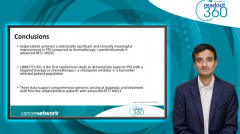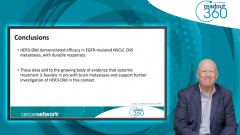
LIBRETTO-431: Selpercatinib in RET Fusion–Positive NSCLC
A medical oncologist discusses data from the LIBRETTO-431 clinical trial looking at first-line selpercatinib vs chemotherapy and pembrolizumab in RET fusion–positive NSCLC.
Episodes in this series

This is a synopsis of a Readout 360 series featuring Sandip P. Patel, MD, of UC San Diego Moores Cancer Center; Joshua K. Sabari, MD, of NYU Langone’s Perlmutter Cancer Center; and Alexander I. Spira, MD, PhD, FACP, of Virginia Cancer Specialists.
Sandip P. Patel, MD, a professor in medical oncology at the University of California, San Diego, presented updates from the European Society for Medical Oncology (ESMO) 2023 conference in thoracic oncology. He discussed the randomized phase 3 study of first-line selpercatinib versus chemotherapy and pembrolizumab in RET fusion-positive non-small cell lung cancer (NSCLC), presented by Lung and colleagues.
Selpercatinib, a highly selective and potent CNS-penetrant RET inhibitor, is approved for the treatment of advanced RET fusion-positive NSCLC in the United States. However, it had not been previously evaluated in a randomized trial in the frontline setting. The LIBRETTO-431 study compared selpercatinib versus chemotherapy (cisplatin or carboplatin plus pemetrexed) with or without pembrolizumab as the control arm in the frontline treatment setting.
The key inclusion criteria were the presence of a RET gene fusion, detected either by tissue-based next-generation sequencing (NGS) or liquid biopsy, and an ECOG performance status of up to 2. Patients with asymptomatic or treated stable brain metastases were allowed to enroll. The primary endpoint was progression-free survival (PFS), stratified by investigators' intent to treat with pembrolizumab.
With a median follow-up of 19 months, selpercatinib demonstrated superior PFS compared to the control treatment (hazard ratio [HR], 0.46), with a median PFS of nearly 25 months versus 11 months in the chemotherapy/chemoimmunotherapy control arm. Other efficacy and safety endpoints, including objective response rate, duration of response, and intracranial response, favored selpercatinib. The time to CNS progression was longer with selpercatinib than control (HR, 0.26).
Dr. Patel emphasized the importance of appropriate molecular testing and classification of patients with NSCLC, despite the associated costs. The LIBRETTO-431 study is the first randomized study to demonstrate superior PFS with targeted therapy versus chemotherapy plus or minus an immune checkpoint inhibitor in a biomarker-selected population. These data support comprehensive genomic testing at diagnosis, using either tissue-based methods (ideally DNA plus RNA-based NGS) or liquid biopsy with cell-free DNA, and the frontline use of selpercatinib in patients diagnosed with advanced RET fusion-positive NSCLC.
*Video synopsis is AI-generated and reviewed by Cancer Network editorial staff.
Newsletter
Stay up to date on recent advances in the multidisciplinary approach to cancer.





















































































